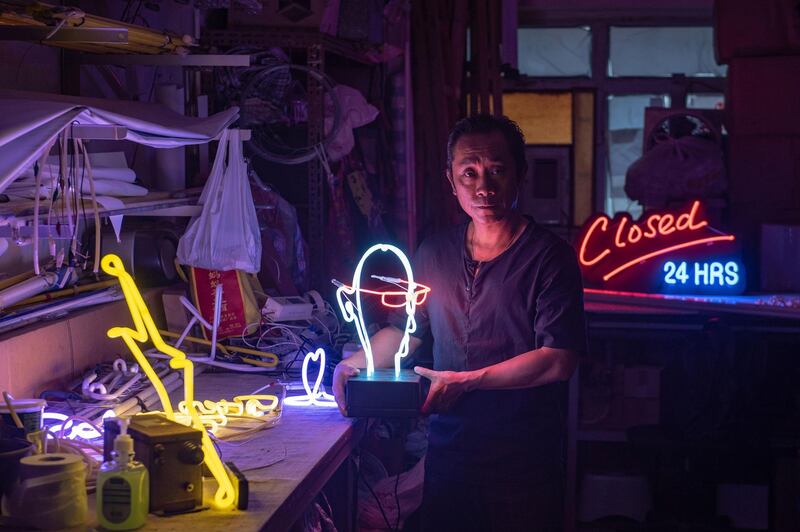Neon sign maker Wu Chi-kai is one of the last remaining craftsmen of his kind in Hong Kong, a city where darkness never really falls thanks to the 24-hour glow of myriads of lights.
During his 30 years in the business, neon came to define the urban landscape, huge flashing signs protruding horizontally from the sides of buildings, advertising everything from restaurants to mahjong parlours.
But with the growing popularity of brighter LED lights, seen as easier to maintain and more environmentally friendly, and government orders to remove some vintage signs deemed dangerous, the demand for specialists like Wu has dimmed.
Despite a waning client-base, 50-year-old Mr Wu continues in the trade, working with glass tubes dusted inside with fluorescent powder and containing various gases including neon or argon, as well as mercury, to create different colours.
He bends them into shape over a powerful gas burner at a scorching 1,000°.
"Being able to twist straight glass materials into the shape I want, and later to make it glow - it's quite fun," he told AFP, although it is not without risks.
Mr Wu works without a safety visor and has been scalded and cut by glass that sometimes cracks and explodes.
"The painful experiences are the memorable ones," he adds philosophically.
His father used to scale Hong Kong's characteristic bamboo scaffolding while installing neon signs across the city.
_______________
Read more:
Golf carts a must-have for wealthy Hong Kong homeowners
Chinese legislators cheer unlimited rule for Xi Jinping
_______________
Believing the installation work too dangerous for his son, he instead encouraged Mr Wu to learn to make the signs as a teenager. Mr Wu became one of only around 30 masters of the craft in Hong Kong, even in neon's heyday.
"When Hong Kong was prospering, all the shops that had ground-level locations wanted to have neon signs to lure customers in. At the time, the government didn't have by-laws on size restrictions for the signs. We just made them as big as the clients wanted them," Mr Wu told The South China Morning Post.
Although demand is now significantly lower than at neon's peak in the 1980s, Mr Wu told AFP there has been revived interest and nostalgia for its gentler glow, immortalised in the atmospheric movies of award-winning Hong Kong director Wong Kar-wai.
Some of Mr Wu's clients are now requesting pieces for indoor decoration.
"I've been working with neon lights all my life. I can't think of anything else I'd be better suited for," he says.
there.”
The decline of neon began around 2000, Mr Wu says, when the owners of neon sign workshops started taking orders to the mainland where they could be made cheaper. This was around the same time that LED lights were introduced, as well as when the Buildings Department began putting restrictions on signs, taking down those that were deemed a safety risk.
“If you ask me, I think LED lights are good – if it’s something neon lights can’t do,” Mr Wu says.
“They are convenient and they can be smaller, and when it comes to changing colours, LED lights are better. They don’t use much electricity too, so it’s a good thing.”






